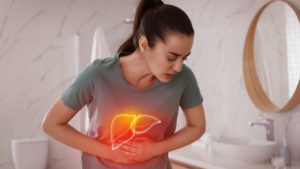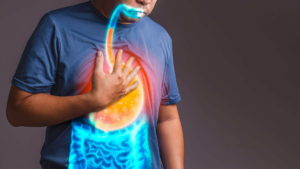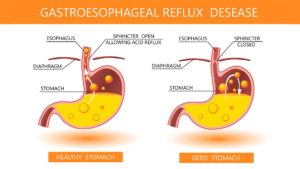Ever had that sudden burning sensation after eating? Yes, Gastroesophageal reflux disease, a condition as though your stomach chose to resist something and greet you with fire instead of kindness. Gastro esophageal reflux is a frequent but not always welcome disturbance of our digestive tract.
The human digestive system is a long track of different but important organs and processes. Sometimes, due to various reasons or causes, there occurs a disturbance in our system that is highly uncomfortable. If prolonged, such situations of uneasiness can lead to worse medical conditions, that take time to recover. Nonetheless, it is wise to do the better to not get into too many complications.
One such case is Gastroesophageal reflux disease by which the digestive system is frequently affected.
Let us understand in detail,
What Is Gastroesophageal Reflux Disease?

This condition is defined by the reflux of stomach acid into the esophagus. This occurrence is caused by a malfunction of the Lower Esophageal Sphincter (LES), a muscle ring that normally functions as a valve to stop stomach contents from flowing backward. The LES’s inability to shut completely allows the harsh acids to irritate and inflame the esophageal lining, which results in GERD.
Gastroesophageal reflux disease stomach pain, Heartburn, or a burning sensation in the chest, and vomiting, the backflow of stomach contents, including acid are the prominent happenings of GERD patients.
At a minor level, it causes discomfort like you don’t feel good and there is this heaviness. However, this illness can cause more than just discomfort; it can also result in more severe side effects.
GERD is caused by numerous conditions; there are symptoms associated, with diagnosis, and gastroesophageal reflux disease treatment. It is essential to identify the symptoms and risk factors.
Both people with GERD and medical professionals must have a thorough understanding of the condition to make educated decisions about management and preventative measures for gastroesophageal reflux disease stomach pain or any horrible symptom.
Here two things need to be understood,
-
Acid reflux
Your stomach’s natural flow is downward and only downward. On the other hand, acid reflux occurs when stomach acid reverses course and goes upward into your esophagus and throat, what causes heartburn. Since the acid irritates and inflames the tissues lining the esophagus, which runs from the stomach through the chest and into the throat, this backward flow may cause discomfort. Acid reflux can present as heartburn, which is a burning pain in the chest that is felt close to the sternum, or as indigestion, which is a burning feeling in the stomach after eating.
Practically everyone occasionally has acid reflux; it is usually an uncomfortable and fleeting episode rather than a chronic issue. But for other people, acid reflux becomes a chronic problem that may eventually cause harm to the esophageal tissues.
-
Gastroesophageal reflux disease
The medical term for persistent acid reflux in the esophagus is gastroesophageal reflux disease or GERD. When acid reflux occurs at least twice a week for several weeks, it is considered chronic. In contrast to infrequent and simple gastroesophageal reflux (GER), GERD is a persistent mechanical issue rather than a passing illness. It signifies a breakdown in the systems meant to stop stomach acid from entering the esophagus inadvertently.
Gastroesophageal reflux disease is a chronic condition that requires continual care techniques to prevent complications and adversely impair an individual’s quality of life.
Symptoms Of Gastroesophageal Reflux Disease

- Heartburn is a burning feeling in the chest that usually occurs after eating.
- The backflow of sour-tasting acid into the mouth or throat
- The inability to swallow
- Chest Pain that could resemble a heart attack in intensity
This condition is what causes heartburn. Heartburn and spewing out are the two main symptoms of Gastroesophageal reflux disease, which is why both conditions are so well-known. Heartburn or this discomfort is accompanied by bitter or sour liquids being regurgitated into the mouth or throat. Because heartburn and regurgitation often occur simultaneously, formal diagnostic testing for GERD may not always be necessary.
Along with the classic symptoms, non-burning chest pain in the middle of the chest that may spread to the back is another sign of GERD.
Dysphagia, or difficulty swallowing, is a symptom that can affect people with Gastroesophageal reflux disease.
Furthermore, this condition can present strangely other than gastroesophageal reflux disease stomach pain, affecting regions other than the esophagus.
Sore throats, chronic coughs, excessive salivation, and even shortness of breath are symptoms that can be linked to disorders of the larynx, lungs, or throat. Understanding this range of symptoms is essential for early detection and treatment of GERD, guaranteeing that patients receive the right care.
The symptoms can vary but can be among these and all need to be considered because in long term nothing is normal. It also should not be taken for granted.
Causes of Gastroesophageal Reflux Disease

Gastro esophageal reflux disease is mostly caused by stomach acid or nonacidic material that frequently backs up into the esophagus. The lower esophageal sphincter, a circular muscle band that surrounds the bottom of the esophagus, weakens or fails to relax properly after swallowing, which causes the stomach’s contents to accidentally reflux back into the esophagus.
As a result, there is a continuous acid reflux that irritates the lining of the esophagus and frequently causes inflammation.
The following conditions and factors increase the likelihood of getting GERD:
Obesity: Carrying too much weight puts extra strain on the abdomen, which worsens the lower esophageal sphincter’s breakdown.
Pregnancy: Gastroesophageal reflux disease can develop more easily during pregnancy due to hormonal changes and increased abdominal pressure.
Disorders of the Connective Tissues: Disorders of the connective tissues, such as scleroderma, might impair the lower esophageal sphincter’s performance.
Delays in Stomach Emptying: Situations that cause the stomach to empty more slowly can lead to an extended period where the esophagus is exposed to stomach acid.
Smoking: Smoking decreases the lower esophageal sphincter, which increases the risk of acid reflux in people.
Eating Patterns: Eating late at night or consuming heavy meals can raise the risk of acid reflux.
Risk Factors of Gastroesophageal Reflux Disease

Untreated gastroesophageal reflux disease (GERD) can have far-reaching effects after its initial symptoms go away and may eventually lead to serious complications. Complications from persistent esophageal inflammation include the following:
- Esophagitis: Prolonged exposure to stomach acid can cause inflammation by eroding the tissue lining the esophagus. Esophagitis is the medical term for this ailment, which can cause bleeding and the development of open sores or ulcers. The symptoms of esophagitis include pain and trouble swallowing, which can seriously lower a person’s quality of life.
- Esophageal Stricture: If stomach acid continues to harm the lower esophagus, scar tissue may form. Significant swallowing issues resulting from this constriction of the food channel necessitate medical attention and assistance.
- Esophagus Barrett: Esophagus Barrett, in which the tissue lining the lower esophagus changes as a result of prolonged acid exposure, is one of the more dangerous side effects of Gastroesophageal reflux disease. There is a higher chance of esophageal cancer linked to these alterations, which are regarded as precancerous. To lower the chance that Esophagus Barrett will advance to esophageal cancer, it is imperative to monitor and treat the condition.
While these consequences are possible results of untreated Gastroesophageal reflux disease, it is important to remember that the risk can be greatly reduced by prompt diagnosis and appropriate medication.
A key factor in stopping the development of more serious consequences from Gastroesophageal reflux disease is avoiding its progression through medication, lifestyle changes, and, in certain situations, surgical procedures. To guarantee the best potential results and lower the risk of long-term consequences, people with GERD must adhere to recommended treatment plans and schedule regular medical follow-ups.
Bonus Tips
Using home remedies and lifestyle changes can help manage and reduce the symptoms of Gastroesophageal reflux disease (GERD). The following are some actions that could be advantageous:
- Breathing Techniques: Including deep breathing techniques in your regimen might help in stress relief and relaxation. Because Gastro esophageal reflux symptoms have been linked to stress, practicing breathing to manage stress may help reduce symptoms.
- Dietary Choices: Select meals and drinks that are less likely to cause acid reflux. Incorporate whole grains, lean meats, non-acidic fruits, and veggies into your diet.
- Weight management: Retaining a healthy weight will help minimize abdominal pressure and lower the chance of lower esophageal sphincter dysfunction, which is a contributing factor to gastroesophageal reflux disease (GERD). A balanced diet and regular exercise are essential for managing weight.
- Stop Smoking: People with Gastroesophageal reflux disease need to stop smoking. Smoking increases the risk of acid reflux and weakens the lower esophageal sphincter. Quitting smoking has numerous health benefits, one of which is an intense reduction in GERD symptoms.
- Meal Timing and Size: Keep your distance from big, filling meals, particularly in the evening. The digestive tract may handle smaller, more frequent meals throughout the day more easily. Furthermore, it is preferable to wait two to three hours after eating before lying down or going to bed to avoid stomach contents refluxing into the esophagus.
Gastroesophageal reflux disease treatment, awareness, and basic understanding are extremely important to avoid any worse conditions.
However, it is wise to ensure that Gastroesophageal reflux disease should be addressed carefully and one should speak with a healthcare provider.













